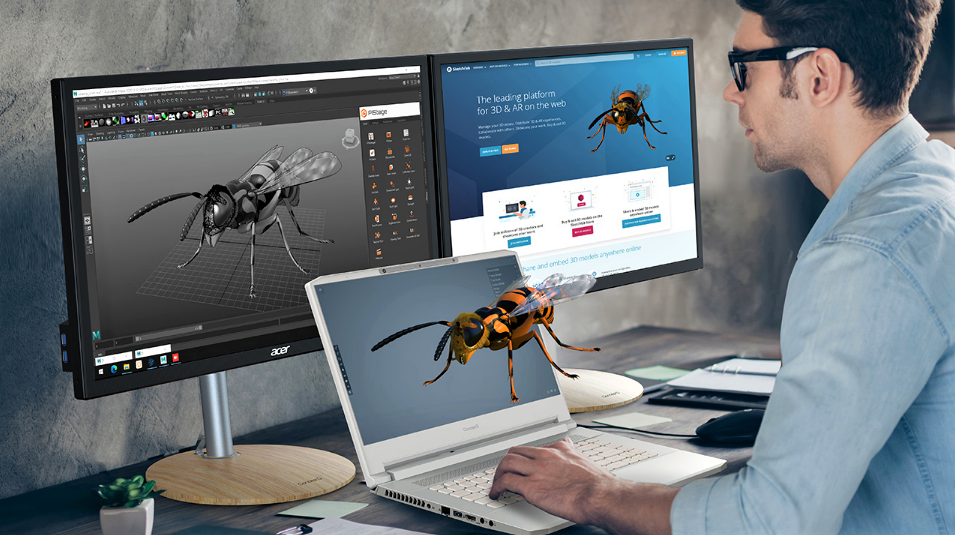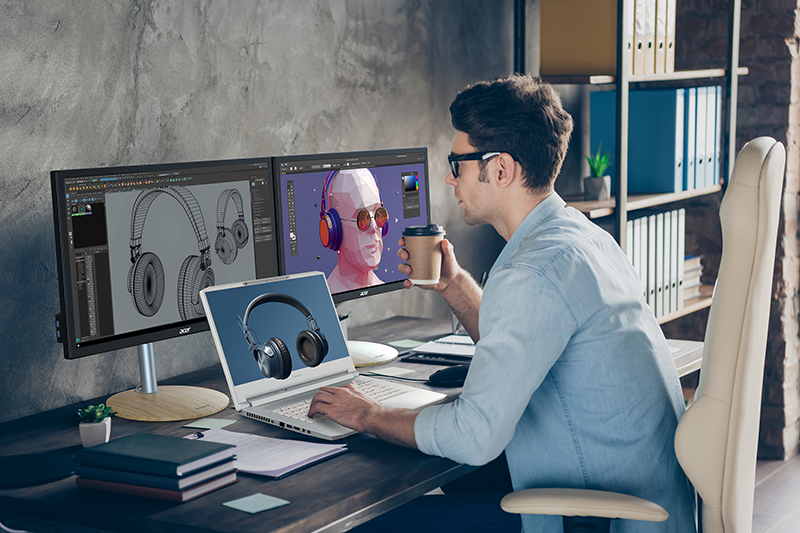Seeing is (barely) believing
I was lucky enough to be invited to London for a special event celebrating Acer’s ConceptD range of creator-focused devices. During the day we were treated to a tasty burger, a graffiti lesson (that showed me how much harder it is to do well than you might think), and some good company with fellow tech enthusiasts.

As much as I love a free meal and good conversation, the tech was the real star of the show. I got to see some stunning devices from the ConceptD range, including the ConcetD 7 Ezel and its inspired hinged display, but one laptop, in particular, was housing something very, very special. This was the only one of these laptops in the whole of Europe, and I got to go hands-on with it.
SpatialLabs
If you saw the Next@Acer presentation earlier this year, chances are you saw the announcement for something called SpatialLabs. This is a new display technology and software that utilises a lenticular display and real-time eye tracking to produce a glasses-free 3D image. Forget everything you know about 3D displays, what Acer and SpatialLabs have achieved here is ground-breaking.
The first demonstration I was shown was a pre-rendered scene using Unreal Engine. During the video, you are taking a first-person stroll down a sci-fi themed street, with mechs stomping around and explosions and gunfire raining down around you. Instantly I was impressed by how particles and scenery were projected into the foreground. Most 3D displays I’ve seen tend to be good at adding depth beyond the screen, but the SpatialLabs display excels at pushing things out towards you.
Thanks to the dual eye-tracking cameras, SpatialLabs had another trick up its sleeve. As you move your head around the screen, you can change the viewpoint, looking up, down and around the scene. It’s a similar effect to what you get with an AR headset, except here, you don’t need a bulky head-mounted display. We’re not talking small movements, either. I was able to look up to the sky and down to the ground, and all the way to either side. The potential for gaming or immersive movie watching is huge.
Model viewer
The second demonstration was by far the most impressive, though. SpatialLabs Model Viewer allows you to import 3D models and view them on the stereoscopic display. I was shown a model of a sheep skull and handed a mouse that I could use to not only move the model around the display but also adjust its placement within the 3D space. This is in addition to eye-tracking, which once again lets you physically move around the object to see it from different angles.

I was gobsmacked. With the laptop’s 4K display, this model was pin-sharp and photo-realistic. First, I moved the model as far into the (virtual) distance as I could, with the skull shrinking into the depths of the display. It was when I brought the model forwards that I was truly astounded, though. I was stood maybe 3 feet from the display, and I was already grinning when I brought it out about a foot from the display, but it kept coming, and coming…
At its peak, I had this enormous skull hovering just inches in front of my face. It’s so hard to do justice to what I was seeing with words. It’s not like VR, where because your eyes are so close to the display you can pick out individual pixels. I had expected it to become blurry or softer in focus, but it was as clear as if someone were holding it in front of my face.
In addition to viewing models and tech demos, SpatialLabs Player lets you watch any SBS 3D content with the lenticular display. This includes stereoscopic display compatible movies, games and the reams of 3D content on sites like YouTube. Unfortunately, they didn’t have any 3D video to show us (and I’d already hogged the display long enough staring at that skull), so I can’t comment on how well the display handles image depth and projection for movies compared to a typical 3D or VR display.

One of a kind
This is prototype technology, and not without its limitations. As this was on a 15-inch display, there was obviously a limit to the perceived size, but the clarity was exceptional. If they can incorporate this technology into much larger panels, I’ll be lining up with pockets full of cash to throw at them.
Another thing that the display can’t yet handle is multiple viewers. This is due to it needing to track your eyes for positional viewing. It may be possible that they could develop a version that displays the 3D image at a static viewpoint allowing multiple viewers to see the 3D image together. I’m still not sure whether it could kickstart the adoption of consumer 3D displays once again, but with a little refinement, this could sway the minds of a lot of people.
I still own and use a 3D TV, but the public has by and large fallen out of love with the tech. This glasses-free implementation, however, removes all of the barriers that put people off 3D to begin with: having to wear glasses, reduced brightness with passive 3D displays, or flickering caused by active 3D. Just move in front of the display and enjoy! This is purely speculation, of course, as for its intended purpose it is already revolutionary.
Get creative
I’ve been coming at this from the perspective of a tech enthusiast, but most of my work revolves around gaming. The SpatialLabs technology has been primarily designed for creative professionals, though, and putting myself into their shoes I can see how useful it could be. With the use of a second display, you can edit your models in real-time, and instantly see the results in front of you.

Whether you are creating animation for a multi-million dollar movie or designing assets for games, the way you can instantly and accurately assess and share the work you have just done could dramatically improve your workflow. Time is always critical in development, so anything that speeds up the process can greatly improve the productivity of your team.
The same is true for anyone designing physical products. With the click of a switch, you can instantly get a stunning 3D projection of your product directly in front of you. I can’t wait to see how SpatialLabs technology is used in the right hands. The possibilities for real-world application of this technology are boundless, and I’m sure we will see some genius ideas that I couldn’t even dream of.

I could talk for hours about how good SpatialLabs is, but until you see it with your own eyes it’s hard to grasp just how impressive it really is. This isn’t just going to be limited to one or two laptops, either. There’s nothing to stop these displays from being used in any laptop, monitors, TVs, even handheld devices. Considering this was an early-stage development model, it’s incredible how advanced and capable the tech is. Once it’s been fully refined and reaches production, demand is likely to be very high.
If you get the chance to see SpatialLabs at any trade shows or events in the near future, do it. It’s worth every second.
Acer’s ConceptD range
It wasn’t just the SpatialLabs equipped laptop that we got to see (although it was the only one we got to play with). Of the rest, I loved the naturalistic elements they’ve used in their construction. The primarily white colourway used is effortlessly stylish and is well suited to the office or home of creative professionals. The monitors stand on wooden bases, and there’s a real wood panel atop the ConceptD 300, 500 and 700. I’ve seen it plenty of times in images but it looks so much better in person.
Another personal highlight was the ConceptD CP7 monitor. This G-Sync Ultimate monitor has a 4K UHD display, 144Hz refresh rate, DisplayHDR 1000 certification, Pantone validated colour (99% AdobeRGB, 93% DCI-P3) and a Delta E of <1. The quoted price if I recall correctly was about £1,200, which may seem pricey for a 27” monitor, but to improve on this you’re getting into the realms of reference-level displays that cost tens of thousands. When you look at it like that, £1,200 starts to look like a bit of a bargain!
They have devices suited to all budgets, ranging from entry-level i7 processors and RTX 3050 GPUs all the way up to professional-grade Intel Xeon and Nvidia Quadro RTX 4000 components.
There’s so much more of the ConceptD range I’d like to talk about, but this article is long enough already. Check back in future when we should have more news and reviews of Acer’s outstanding line of creator-focused devices, and for gaming fans, we will be reviewing the new Acer Predator devices in the coming months.
Check out all of our Acer news and reviews here
Visit the Official Acer ConceptD SpatialLabs page
Here’s the Acer ConceptD Homepage
Follow Acer on Twitter: @acer_uk

With thanks to Karen, Betlem and all of the Acer team for inviting us to and organising this event!


